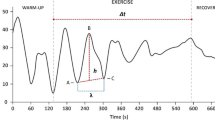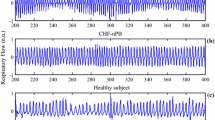Abstract
Exercise periodic breathing (EPB) is associated with exercise intolerance and poor prognosis in patients with heart failure (HF). However, EPB detection during cardiopulmonary exercise test (CPET) is difficult. The present study investigated the use of a wireless monitoring device to record the EPB during CPET and proposed quantization parameter estimates for the EPB. A total of 445 patients with HF were enrolled and underwent exercise tests. The ventilation data from the wearable device were compared with the data obtained during the CPET and were analyzed based on professional opinion and on 2 automated programs (decision tree [DT] and oscillatory pattern methods). The measurement accuracy was greater with the DT method (89 %) than with the oscillatory pattern method (75 %). The cutoffs for EPB recognition using the DT method were (1) an intercept of the regression line passing through the minute ventilation rate vs. the time curve during the recovery phase ≥64.63, and (2) an oscillatory phase duration to total exercise time ratio ≥0.5828. The wearable device was suitable for the assessment of EPB in patients with HF, and our new automated analysis system using the DT method effectively identified the EPB pattern.





Similar content being viewed by others
References
Arena R, Myers J, Abella J, Peberdy MA, Pinkstaff S, Bensimhon D, Chase P, Guazzi M (2008) Prognostic value of timing and duration characteristics of exercise oscillatory ventilation in patients with heart failure. J Heart Lung Transpl 27:341–347. doi:10.1016/j.healun.2007.11.574
Ben-Dov I, Sietsema KE, Casaburi R, Wasserman K (1992) Evidence that circulatory oscillations accompany ventilatory oscillations during exercise in patients with heart failure. Am Rev Respir Dis 145:776–781. doi:10.1164/ajrccm/145.4_Pt_1.776
Breiman L, Friedman JH, Olshen RA, Stone CJ (1984) Classification and regression trees. Chapman & Hall/CRC, Boca Raton
Cohen-Solal A, Laperche T, Morvan D, Geneves M, Caviezel B, Gourgon R (1995) Prolonged kinetics of recovery of oxygen consumption after maximal graded exercise in patients with chronic heart failure: analysis with gas exchange measurements and NMR spectroscopy. Circulation 91:2924–2932. doi:10.1161/01.CIR.91.12.2924
Corrà U, Giordano A, Bosimini E, Mezzani A, Piepoli M, Coats AJ, Giannuzzi P (2002) Oscillatory ventilation during exercise in patients with chronic heart failure: clinical correlates and prognostic implications. Chest 121:1572–1580. doi:10.1378/chest.121.5.1572
Corrà U, Pistono M, Mezzani A, Braghiroli A, Giordano A, Lanfranchi P, Bosimini E, Gnemmi M, Giannuzzi P (2006) Sleep and exertional periodic breathing in chronic heart failure: prognostic importance and interdependence. Circulation 113:44–50. doi:10.1161/CIRCULATIONAHA.105.543173
Dhakal BP, Murphy RM, Lewis GD (2012) Exercise oscillatory ventilation in heart failure. Trends Cardiovasc Med 22:185–191. doi:10.1016/j.tcm.2012.07.018
Evans JD (1996) Straightforward statistics for the behavioral sciences. Brooks/Cole Pub. Co., Pacific Grove
Garde A, Giraldo BF, Jané R, Latshang TD, Turk AJ, Hess T, Bosch MM, Barthelmes D, Merz TM, Hefti JP, Schoch OD, Bloch KE (2015) Time-varying signal analysis to detect high-altitude periodic breathing in climbers ascending to extreme altitude. Med Biol Eng Comput 53:699–712. doi:10.1007/s11517-015-1275-x
Kato J, Koike A, Hoshimoto-Iwamoto M, Nagayama O, Sakurada K, Sato A, Yamashita T, Wasserman K, Aonuma K (2013) Relation between oscillatory breathing and cardiopulmonary function during exercise in cardiac patients. Circ J 77:661–666. doi:10.1253/circj.CJ-12-0925
Khoo MC, Kronauer RE, Strohl KP, Slutsky AS (1982) Factors inducing periodic breathing in humans: a general model. J Appl Physiol Respir Environ Exerc Physiol 53:644–659
Kremser CB, O’Toole MF, Leff AR (1987) Oscillatory hyperventilation in severe congestive heart failure secondary to idiopathic dilated cardiomyopathy or to ischemic cardiomyopathy. Am J Cardiol 59:900–905. doi:10.1016/0002-9149(87)91116-7
Leite JJ, Mansur AJ, de Freitas HF, Chizola PR, Bocchi EA, Terra-Filho M, Neder JA, Lorenzi-Filho G (2003) Periodic breathing during incremental exercise predicts mortality in patients with chronic heart failure evaluated for cardiac transplantation. J Am Coll Cardiol 41:2175–2181. doi:10.1016/S0735-1097(03)00460-1
Lorenzi-Filho G, Bradley D (2002) Cardiac function in sleep apnea. In: Pack AI (ed) Sleep apnea. Marcel Dekker, New York, pp 377–410
Marantz PR, Tobin JN, Wassertheil-Smoller S, Steingart RM, Wexler JP, Budner N, Lense L, Wachspress J (1988) The relationship between left ventricular systolic function and congestive heart failure diagnosed by clinical criteria. Circulation 77:607–612. doi:10.1161/01.CIR.77.3.607
Murphy RM, Shah RV, Malhotra R, Pappagianopoulos PP, Hough SS, Systrom DM, Semigran MJ, Lewis GD (2011) Exercise oscillatory ventilation in systolic heart failure: an indicator of impaired hemodynamic response to exercise. Circulation 124:1442–1451. doi:10.1161/CIRCULATIONAHA.111.024141
Naughton M, Benard D, Tam A, Rutherford R, Bradley TD (1993) Role of hyperventilation in the pathogenesis of central sleep apneas in patients with congestive heart failure. Am Rev Respir Dis 148:330–338. doi:10.1164/ajrccm/148.2.330
Piepoli MF, Ponikowski PP, Volterrani M, Francis D, Coats AJS (1999) Aetiology and pathophysiological implications of oscillatory ventilation at rest and during exercise in chronic heart failure. Do Cheyne and Stokes have an important message for modern-day patients with heart failure? Eur Heart J 20:946–953. doi:10.1053/euhj.1999.1506
Ramar K, Dort LC, Katz SG, Lettieri CJ, Harrod CG, Thomas SM, Chervin RD (2015) Clinical practice guideline for the treatment of obstructive sleep apnea and snoring with oral appliance therapy: an update for 2015. J Clin Sleep Med 11:773–827. doi:10.5664/jcsm.4858
Sun XG, Hansen JE, Beshai JF, Wasserman K (2010) Oscillatory breathing and exercise gas exchange abnormalities prognosticate early mortality and morbidity in heart failure. J Am Coll Cardiol 55:1814–1823. doi:10.1016/j.jacc.2009.10.075
Tumminello G, Guazzi M, Lancellotti P, Piérard LA (2007) Exercise ventilation inefficiency in heart failure: pathophysiological and clinical significance. Eur Heart J 28:673–678. doi:10.1093/eurheartj/ehl404
Wang JS, Wu MH, Mao TY, Fu TC (1985) Hsu CC (2010) Effects of normoxic and hypoxic exercise regimens on cardiac, muscular, and cerebral hemodynamics suppressed by severe hypoxia in humans. J Appl Physiol 109:219–229. doi:10.1152/japplphysiol.00138.2010
Yamashiro SM (2007) Non-linear dynamics of human periodic breathing and implications for sleep apnea therapy. Med Biol Eng Comput 45:345–356. doi:10.1007/s11517-006-0153-y
Zhang Z, Zheng J, Wu H, Wang W, Wang B, Liu H (2012) Development of a respiratory inductive plethysmography module supporting multiple sensors for wearable systems. Sensors (Basel) 12:13167–13184. doi:10.3390/s121013167
Zurek M, Corrà U, Piepoli MF, Binder RK, Saner H, Schmid JP (2012) Exercise training reverses exertional oscillatory ventilation in heart failure patients. Eur Respir J 40:1238–1244. doi:10.1183/09031936.00167011
Acknowledgments
We thank the Genomic Medicine Research Core Laboratory (GMRCL) of Chang Gung Memorial Hospital, the National Core Facility Program for Biotechnology (Bioinformatics Consortium of Taiwan; NSC 100-2319-B-010-002), and Chun-Houh Chen for his statistical assistance.
Funding
This work was supported by grants from the National Science Council of Taiwan (Grant Number: NSC 102-2628-B-182A-001-MY3), Chang Gung Memorial Hospital (Grant Number: CMRPG2A0162), and the Healthy Aging Research Center of Chang Gung University (Grant Number: EMRPD1A0841).
Author information
Authors and Affiliations
Corresponding author
Ethics declarations
Conflict of interest
The authors declare that they have no conflict of interest.
Ethical standards
All procedures performed in studies involving human participants were in accordance with the ethical standards of the institutional and/or national research committee and with the 1964 Helsinki declaration and its later amendments or comparable ethical standards. Informed consent was obtained from all individual participants included in the study. The study was approved by the Institutional Review Board of Chang Gung Memorial Hospital, Taiwan (99-2546B), and was registered at clinicaltrial.gov (NCT01454128).
Rights and permissions
About this article
Cite this article
Fu, TC., Lin, WC., Wang, JS. et al. Detection of exercise periodic breathing using thermal flowmeter in patients with heart failure. Med Biol Eng Comput 55, 1189–1198 (2017). https://doi.org/10.1007/s11517-016-1581-y
Received:
Accepted:
Published:
Issue Date:
DOI: https://doi.org/10.1007/s11517-016-1581-y




